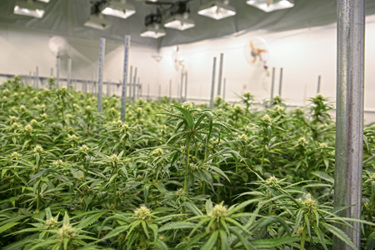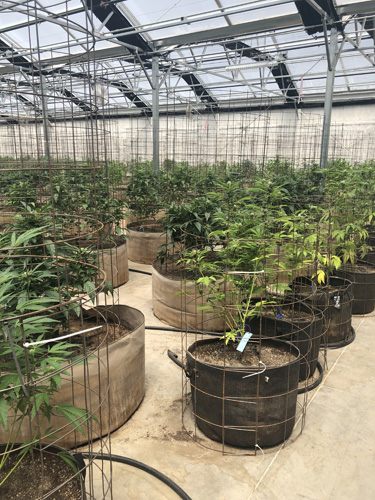Challenges Surrounding Developing Cannabis-Wastewater Handling And Treatment Best Practices
By Brenda Faz

Introduction
With any new and upcoming industry, regulations surrounding product development, market research, and potential regulatory impacts must be evaluated. But what happens when that new industry involves a product that is illegal to produce on a federal level, but legal on a state level? This unusual circumstance dictates a more expansive set of considerations and potential issues for all stakeholders involved.
The cannabis industry was first given an opportunity for legalization in 1996, when California voters passed Proposition 215 legalizing the use of medical marijuana in the state. Since then, regulations have evolved on a state level allowing different degrees of criminalization and legalization. Marijuana possession, from a criminalization standpoint, is either legalized, decriminalized, or fully illegal. Legalized marijuana is state-approved for both medical and recreational use. Decriminalized means there is still a penalty for possession, but it is no longer treated as a federal offense and offenders in these states receive a penalty similar to a misdemeanor. In states that still apply the federal regulations against marijuana possession, as outlined in the Controlled Substances Act, marijuana is fully illegal. As of November 2020, only eight U.S. States remain on the fully Illegal side of board in not allowing marijuana use for neither medical nor recreational use. Two of those eight states have decriminalized possession. This multibillion-dollar industry is expected to continue expanding over the next several years, with some studies showing revenue generation to more than triple compared to today’s figures.
As the cannabis industry grows and legalization expands, the impacts of wastewater generated from cannabis processing requires research that can inform and enable regulators and policymakers to make the best decisions to formalize the related wastewater regulation currently under development. The difficulty in developing Best Management Practices and Good Manufacturing Practices for cannabis is the lack of existing regulatory framework from federally funded agency programs such as the Food and Drug Administration or the Environmental Protection Agency. Because of this void, states have had to develop their own policies based on the limited information and research that has been published to date. In Washington State, for example, process water from cannabis facilities is seen as industrial wastewater, and must be collected, potentially pretreated, and removed from the facility.
Specific to the wastewater industry, there is very little published data showing the impacts of cannabis process wastewater to overall treatability practices, whether it be in large municipalities or onsite treatment systems. This lack of reliable data has made it challenging for treatment plant operators and wastewater system designers to understand, design, and operate with this comprehensive knowledge about the potential impacts this wastewater will have on their systems.
3 Steps Toward Understanding Potential Cannabis Process Wastewater Impacts
The first key in understanding how the growth of the cannabis industry may impact a facility and operations is to become educated about the local status of legalization and the process for facilities to establish cannabis operations in the area. For example, as of 2019 California reported more than 10,000 businesses licensed in the adult-use cannabis retail business. Each state has an allowance, or not, on how many permits can be issued for these types of establishments. These local rules and regulations, alongside climate and water availability, will steer potential business owners to establish these cannabis operations in certain areas and knowledge of the cannabis “climate” can help in developing a first assessment of the potential impact to the facility with which you are working.
The second step is to become educated regarding local regulations for manufacturing practices and understand the associated standardization of wastewater generation. Wastewater solutions vary depending on the state or local authority. Currently, there is no specific regulation surrounding onsite wastewater treatment systems and the allowance of cannabis process wastewater. Municipal plants are regulated, in most areas, on a case-by-case basis. Some facilities are recycling wastewater for a zero discharge, while other industrial-scale facilities are employing collect-store-haul strategies similar to agricultural and pharmaceutical hazardous waste practices.
Thirdly, take note of how other facilities are handling cannabis wastewater and find out how it may be impacting the facility. Some local municipalities are requiring any cannabis-related facility to characterize their waste before they allow that location to release wastewater into the wastewater treatment plant. Others are employing costly methods of treating the wastewater onsite before discharge. These technologies may include reverse osmosis and/or evaporation — processes that remove nutrients and solids from the waste stream resulting in a cleaner effluent. There is no single method of evaluation and design, or procedure implementation. However, many local municipalities and regulatory authorities are working to develop individualized plans for disposal and/or pretreatment based on the type of facility. This is most typical in states where growing and processing operations have been established for some time.
Cannabis Cultivation And Processing Produces Differing Wastewater Challenges
When designing a cannabis wastewater treatment system or determining a plan for an individual cannabis facility related to wastewater treatment, the key is understanding the type of cannabis produced at the facility and what the facility’s current practices are for growing, processing, and/or manufacturing cannabis goods. Whether medical or recreational, cannabis plants are grown similarly. The main difference is in cultivation and processing. The other difference is the CBD versus THC concentrations.
Medical vs. Recreational Marijuana
Medical marijuana focuses on CBD extraction and processing. This is the active ingredient in cannabis that provides the calming and healing effects that help with certain medical conditions. It does not have the psychoactive impact that THC does, or the “high” that people look for in recreational use. These medical marijuana facilities undergo a stricter, more controlled process with less pesticides, measured nutrient usage, and less environmental impact variability due to the use of grow houses. Therefore, these medical-grade facilities tend to be more regulated and have better-established Good Manufacturing Practices in place.

Indoor cannabis grow house
Wastewater Varies Depending On The Type Of Facility
When working with cannabis wastewater, there are three basic types of cannabis facilities with differing categories of concern: growers, processors, and end-product manufacturers. All of these facilities have treatment needs, but because the wastewater produced at each varies, as does the standard practice, they need to be considered individually. Breaking this down can help a regulator, designer, or operator determine best practices for the particular wastewater management challenge.
- Growers’ use of conventional insecticides and fertilizers will vary based on indoor versus outdoor grow facilities. Pesticide use would need to be considered for an outdoor growing operation, which could potentially cause toxicity issues in the wastewater treatment system. Also, understanding fertilizer use and application practices will help a designer determine what level of nutrients may be entering the waste stream. Nutrients, such as nitrogen, are often regulated effluent parameters by the wastewater industry. Determining what products are being employed in what quantities, as well as application practices and water usage, will help to detail the related waste characterization. If a grower is utilizing organic growing practices, there will be a lower impact on the waste stream because there is no use of pesticides in organic growing practice and therefore no threat of toxicity from these chemicals. Additionally, organic growers tend to limit fertilizer use. In all grower scenarios, there will be spent plant material that will be part of the waste challenge because this material adds solids, leading to higher organic loading and potential for system clogging.

Outdoor cannabis growing
- Processors have waste oils, terpenes, and solvents that will potentially require a greater level of treatment prior to disposal. They will also have spent organic material. Understanding the extraction methods a processor is using, how often they are running these procedures, how much waste is being generated, and on what type of timeline is key to handling this waste stream. Related to water use and solvent use, some extraction methods incorporate the use of solvents, which add organic loading and potential toxicity, while other methods do not.
- End-product manufacturers’ wastewater streams have their own set of challenges. This waste may include oils, surfactants, industrial-type cleaners, waxes, and edibles-food-processing byproducts that require processing. Too many oils are a challenge to wastewater systems. They float and don’t easily degrade, also causing clogging and odors. Other byproducts just carry unknowns when related to trying to develop a treatment plan.
One other consideration to factor into a wastewater treatment plan is any additional uses of the facility, such as those facilities that produce marijuana products for recreational use and also serve as entertainment venues. The presence of human waste at these venues adds another flow and organic loading consideration to the treatment plan.
Checklist Of 4 Evaluation Data Sets For Cannabis Wastewater Treatment Professionals
- Type of facility/operation
- Grower
- Processor
- End-product manufacturer
- Combo of these
- Medical or recreational
- Indoor or outdoor
- Wastewater consistency
- Process
- Runoff
- Domestic
- Chemical use and/or residue process employed
- Wastewater parameters
- Average daily flow
- Influent expectations
- Effluent requirements
- Site constraints or characteristics
- Water usage
- Recycling practices
- Local town or state regulations and design criteria
Conclusion
In summary, knowledge of local regulations and the permitting process for cannabis facilities is a good first step toward recognizing a potential impact to your area or wastewater operations. Research into what others may be employing to mitigate waste generation and handle cannabis process water successfully is helpful. Finally, knowing the processes being utilized by any facility requesting permitting to discharge, either onsite or to a community system, can provide clues and information on potential wastewater characteristics and challenges.
Given the conflict between federal and state legalization related to the cannabis industry, a regulatory framework that exists for most products has not yet been developed. This leaves every situation subject to having a unique approach for operations and waste treatment. The wastewater industry needs to continue sharing research and practical knowledge about cannabis wastewater treatment best practices to enable the framing of standardized regulatory policy and best practices to benefit regulators, manufacturers, and wastewater professionals and protect environmental and public health.
Brenda Faz (bfaz@deltatreatment.com) is the Engineered Systems Consultant for the Southern Region for Delta Treatment Systems. Brenda assists developers and engineers in designing wastewater treatment systems that will optimize treatment performance for their projects. Prior to working for Delta, Brenda spent 15 years in the environmental testing industry, doing bench-scale treatability studies for municipal wastewater plants as well as standard analytical testing for soils and waters under both Standard Methods and ASTM methodologies. Brenda holds a bachelor’s degree in Environmental Science from Texas A&M University, a master’s degree in Environmental Management from the University of Maryland University College, and she is currently a PhD student at Louisiana State University in the Environmental Science program. Delta Treatment Systems is a subsidiary of Infiltrator Water Technologies.
